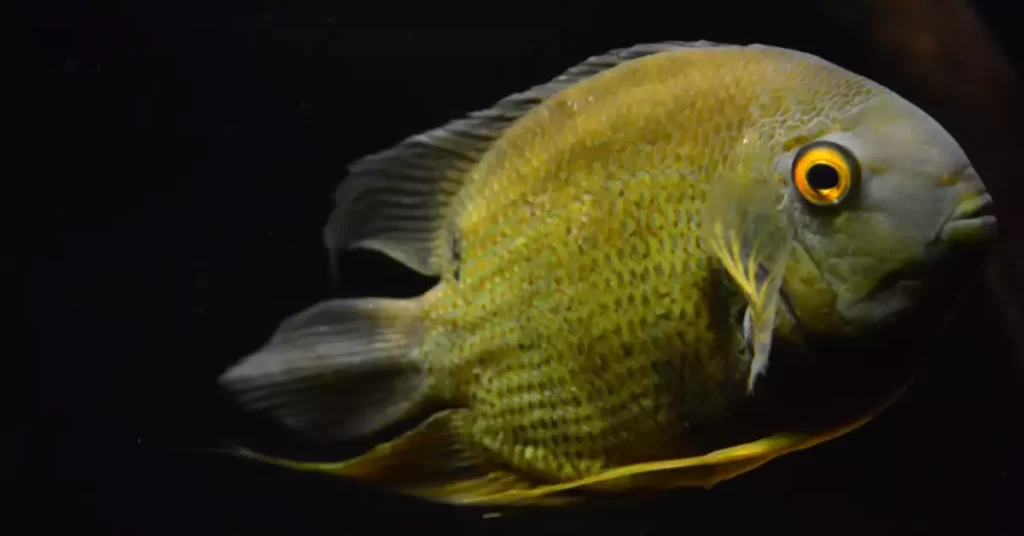Fish are fascinating creatures, with many species living in a diverse range of aquatic habitats.
A common question among fish enthusiasts and casual observers alike is whether fish can see at night.
In this article, we will explore this question in depth, discussing the unique adaptations fish have developed to see in low-light conditions and the various factors that can impact their nighttime vision. Let’s dive in!
Overview: Vision in Fish
Fish Eye Structure and Function
To understand how fish can see at night, it’s essential to know the basics of fish eye structure and function.
Fish eyes are similar to human eyes in many ways, with a cornea, lens, iris, and retina. However, some unique adaptations enable fish to see in their aquatic environment.
Rods and Cones: Key to Fish Vision
Fish, like humans, have two types of photoreceptor cells in their retinas: rods and cones.
Rods are responsible for low-light vision, while cones are responsible for color vision and visual acuity in bright light conditions. The ratio of rods to cones in a fish’s eye can provide insight into its ability to see at night.
Fish Adaptations for Night Vision
Nocturnal Fish: Masters of the Dark
Nocturnal fish species have evolved to see well in the dark, as they are most active during nighttime hours.
These fish typically have larger eyes, a high ratio of rods to cones, and other adaptations that enhance their ability to see in low-light conditions.
Deep-Sea Fish: Navigating the Abyss
Deep-sea fish live in an environment where sunlight rarely penetrates.
As a result, these fish have developed unique adaptations, such as bioluminescence, to navigate and communicate in the deep ocean.
Diurnal Fish: Daytime Dwellers
Diurnal fish species are most active during the day and typically have a higher concentration of cones in their retinas.
However, they may still have some ability to see at night, albeit with less acuity than nocturnal or deep-sea species.

Factors Affecting Fish Night Vision
Light Pollution and Its Impact on Fish
Light pollution from human activities can impact fish’s nighttime vision by disrupting their natural light-dark cycles.
Water clarity can significantly affect a fish’s ability to see at night.
This can have various effects on fish behavior, feeding patterns, and reproductive cycles.
Water Clarity and Fish Vision
Murky or turbid water can scatter light and reduce visibility, making it more challenging for fish to see in low-light conditions.
Age and Vision in Fish
As fish age, their vision can deteriorate, much like in humans. Older fish may have a reduced ability to see at night due to age-related changes in their eyes and retinas.
Enhancing Fish Night Vision: Artificial Lighting
Fishkeepers often use artificial lighting to simulate day-night cycles in aquariums. This can help enhance the nighttime vision of fish and promote their natural behaviors, such as feeding and breeding.
Fish Vision Across Different Environments
Freshwater Fish Night Vision
Freshwater fish, such as catfish and eels, often have adaptations that enable them to see well at night.
These adaptations can include larger eyes, a higher concentration of rod cells, and even the ability to detect electrical signals from nearby animals.
Saltwater Fish Night Vision
Saltwater fish species, such as sharks and rays, can also possess adaptations for nighttime vision.
Many saltwater fish have a specialized reflective layer behind their retina, called the tapetum lucidum, which enhances their ability to see in low-light conditions.
Brackish Water Fish Night Vision
Brackishwater fish inhabit environments where freshwater and saltwater mix, such as estuaries and mangrove swamps.
These fish may have a combination of adaptations for seeing in both clear and murky water, as well as low-light conditions.
Frequently Asked Questions
Can all fish see in color?
Not all fish can see in color. Some species have only rods in their retinas, which are responsible for low-light vision but do not detect color.
Others have a limited range of color vision, depending on the types and ratios of cones in their eyes.
How do fish sleep if they can see at night?
Fish do not sleep in the same way that humans do, but they do have periods of rest and reduced activity.
Fish can still detect changes in light levels during these rest periods, enabling them to respond to potential threats or other stimuli.
Can fish see ultraviolet (UV) light?
Some fish species can see UV light, which is beyond the range of human vision.
This ability allows them to detect prey, communicate, and navigate their environment more effectively.
UV vision is particularly useful for fish living in clear, shallow water where UV light can penetrate.
Final Thoughts on Fish Night Vision
In conclusion, fish have evolved a remarkable array of adaptations that enable them to see in low-light and nighttime conditions.
These adaptations can vary depending on the species and their specific environmental needs, with some fish being better equipped for nighttime vision than others.
Factors such as light pollution, water clarity, and age can all impact a fish’s ability to see at night.
By understanding these factors and the unique visual adaptations of different fish species, we can better appreciate the complex and fascinating world of fish vision.